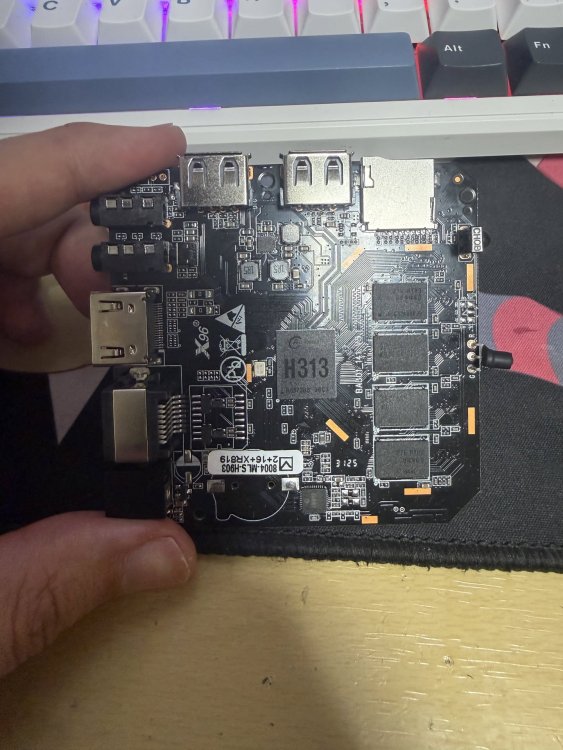Active threads
Showing topics posted in for the last 365 days.
- Past hour
-

mxq pro 4k 5g allwinner h313 can't sd card boot
Ducdanh Nguyen replied to Ducdanh Nguyen's topic in Allwinner CPU Boxes
@Sergey Lepeshkin from the messages, i bought it online and the seller i know him since i bought wires from the shop. I couldnt contact the seller to provide the rom and i think they dont know since they most resell them. Also is it safe to install that file on my box?? Im scared that is going thr brick the box - Today
-
I got interested after reading this thread and ordered an X96Q from AliExpress. The board is marked as V5.1, so I thought it would be straightforward, but after two days of trying, no matter which image I use, it always boots into Android. I tried UART communication, but nothing appeared. I even applied the secure boot patch and built it, just in case, but it still wouldn’t boot. How can I get this machine to boot from an SD card? I’m attaching photos of my board and the extracted DTS for reference. dtb.0.dts
-

CSC Armbian for RK322x TV box boards
Francesco Spossati replied to jock's topic in Rockchip CPU Boxes
I found a TX box X96 Mini with rk3228 chip and I try to boot with multitool but it is stuck with a red ligh. I try multitool and multitool2, with no success, can someone tell me what I am doing wrong ? Thank you -
@Jojo Would you be so kind and lend me a hand here? What I did: clone the repo locally manually changed the files in your PR (csc, dts and modified the .config) run ./compile.sh The problem is - it does not offer the M1S board in the list of targets. I must be missing a step or two. Would you mind checking my steps and advise, please? Never mind - all I needed to do is to click the middle option in the compile menu (Show CSC/WIP/EOS/TVB)
-
It sounds very promising for Espressobin usage and further kernels upgrades. It is yet to discover how could your u-boot port be built and which changes to code should be made for espressobin v5 and v7. I believe, they use the same chip. As you have a working build environment already, it would be worth sharing your pre-built binaries for testing in the 1st run. It could be a big step forward. Probably Armbian could offer them for downloads as well as alternatives in parallel with their own builds.
-
Different soc and even different soc family. This most likely will not work on h618.
-

Gaming experience with Orange Pi 5 (RK3588) on Armbian
nom replied to KhanhDTP's topic in Orange Pi 5
This is truly incredible. I had no idea Mali and Linux has come this far. Though it's a shame things aren't mainlined. -

Orange Pi Zero 3 ili9486 TFT LCD (WaveShare 35a)
robertoj replied to goodfvh _YT_'s topic in Allwinner sunxi
Start with this DTS and change the GPIO for your OPIZ3 https://github.com/raspberrypi/linux/blob/rpi-6.12.y/arch/arm/boot/dts/overlays/piscreen-overlay.dts Or start with your DTS and change the "compatible" line to "compatible=waveshare,rpi-lcd-35" and copy the other parameters of piscreen-overlay.dts if needed Let us know if it works -
TV Box Status Information Template Version 1.0 TV Box Name (example: TX3 mini): T9 CPU (example: amlogic s905w): RK3328 Armbian build file name: Armbian_community_25.11.0-trunk.367_Rk3318-box_trixie_current_6.12.54_minimal.img DTB file used: rockchip/rk3318-box.dtb Kernel Version: 6.12.56-current-rockchip64 Distribution Installed (focal, buster, etc): trixie Working Ethernet (Yes/No):Yes Max Ethernet Speed that works (100/1000): 100 Max Does wifi work (Yes/No): Yes 2/5 Does bluetooth work (Yes/No): Yes Does HDMI audio work (Yes/No): some noise Additional Comments (provide any additional information you feel is important): IR Receiver yes 5 Digit display working: yes MASKROM PINS for recovery flashing available on the back side. SOC RK3328 RAM 4Gx4 D9PQL VFD DRIVER FD6551 WLAN CHIP SP6330 32 GB EMMc KLMBG2JENB VT RT9045 vfd.conf rk3318-t9.dtso Log android gpio T9.txt
- Yesterday
-

Help wanted to test a new OpenVFD alternative
GmP replied to Jean-Francois Lessard's topic in Amlogic meson
Update I have opened the box. Indeed the driver is an FD6551 and the SOC is RK3328. I was using the FD655 just because that was the one used in a working vfd-openvfd conf file. So I have just changed the dtso file directive compatible = "fdhisi,fd6551"; The advantage is that 8 levels of intensity are now available using 1..8 in "echo 1 > /sys/class/leds/display/brightness". I did not chage the filename but as a matter of fact it should be as well the working rk3328-t9.dtso. rk3318-t9.dtso -
Any Ubuntu Noble release?
-
the two tv box are quite different.The rk3318-H50 of this post is quite cheap, so are the component inside. By the way for the rk3318-H50: the PMIC is a DF1517, not an usual one. The Board has three leds (one red is power on always on the other two are both blu but I have never seen them on) and a 4 digit display plus (colon) usb, lan and wlan icons. Wifi works with the base configuration 2 and 5 ghz (although some warnings in the log). Bluetooth is recognized as well. I do not see any message related to the IR receiver. By the way it seems to be quite stable. This is the gpio list: android_tv_box_32:/ $ cat /sys/kernel/debug/gpio gpiochip0: GPIOs 0-31, parent: platform/pinctrl, gpio0: gpio-2 ( |vcc_otg_vbus ) out hi gpio-30 ( |vcc_sd ) out hi gpiochip1: GPIOs 32-63, parent: platform/pinctrl, gpio1: gpio-42 ( |bt_default_rts ) out lo gpio-50 ( |reset ) out hi gpio-53 ( |bt_default_poweron ) out hi gpio-56 ( |fd650_scl ) out hi gpio-57 ( |fd650_sda ) out hi gpio-58 ( |bt_default_wake_host) in hi gpiochip2: GPIOs 64-95, parent: platform/pinctrl, gpio2: gpio-81 ( |vcc_host_vbus ) out hi gpio-82 ( |power-led-ir ) out lo gpio-90 ( |power-led-normal ) out lo gpiochip3: GPIOs 96-127, parent: platform/pinctrl, gpio3: The T9 is an old and quite different TVBOX (cames in two flavours rk3318 and rk3328 from Sunwell) and everything is working "out of the box" - wifi, bluetooh, lan, hdmi, ir receiver. It has no leds but a 5 digit display + 6 icons but if you think it would be useful I can open it and peraphs describe it in a different post to avoid confusion. It seems to me that is more widespread as there are configuration files all around. Let me know if it is of ant interest.
-
Hi all, I just installed Armbian with OpenMediaVault on a Odroid HC4 (v25.8.2 for Odroid HC4 running Armbian Linux 6.12.48-current-meson64), when I tried to disable automatic updates in armbian-config it purged a lot of packages including openmediavault. Guess this is a bug, in case where should I report it?
-

Installation Instructions for TV Boxes with Amlogic CPUs
Solder Anget replied to SteeMan's topic in FAQ
IS THERE ANYTHING COMPATIBLE FOR S905Y4 VERSION -
@CyberHaZard Thanks for the feedback. Yes, the internal eMMC is untouched. You can mount these Android partitions in your file system if you want to access them. Thank you for the offer. I already have access to the Android OS, but tests are apriciated Usb3 is not fully implemented yet . It might just be a Linux configuration issue. I still need to investigate. Maybe it's also acting as a device. there could be a switch via GPIO. The front LED display uses the HT1628 chip. There's a driver available at https://github.com/venkatesh4009/TM1628_LED_Driver It's worth a try.
-

Armbian Linux v6.1 - Bluetooth not working - no BT controller found
SM2027 replied to SM2027's topic in Banana Pi M7
A service was created to fix the issue, should be this added to official BPI-M7 image? sudo nano /etc/systemd/system/btattach.service sudo systemctl daemon-reload sudo systemctl enable btattach.service sudo systemctl status btattach.service sudo systemctl start btattach.service sudo systemctl status btattach.service cat /etc/systemd/system/btattach.service [Unit] Description=Bluetooth UART Attach Service After=network.target Before=bluetooth.service [Service] Type=simple ExecStartPre=/usr/sbin/modprobe bluetooth ExecStartPre=/usr/sbin/modprobe hci_uart ExecStart=/usr/bin/btattach -B /dev/ttyS6 -P bcm -S 115200 Restart=always [Install] WantedBy=multi-user.target -
Hi, can you confirm that the OLED is working connecting it to another device (raspberry, Arduino)? It should be properly powered, cables should be checked if ok. Also, check in the spec if pull-up resistors are needed. You can force a scan of all i2c addresses again like this: # Force scan all addresses for i in {0..127}; do sudo i2cget -y 1 $i 2>/dev/null && echo "Device found at: 0x$(printf '%02x' $i)" done
- Last week
-
Getting video acceleration is realtively easy in bookworm, but making it work in Trixie would be newsworthy
-
Thanks for the reply! I bought used and had no luck at all getting things running (this was some time ago and things are hazy). Have you written up your experience anywhere I could look at? Sent from my iPhone using Tapatalk
-

Radxa-cubie-a5e second Ethernet port not work after update
Luca Gerber replied to Samixa's topic in Allwinner sunxi
Hi, if you compile your kernel with "CONFIG_SUN55I_PCK600" set, you'll have the second ethernet port. But you'll loose the wifi adapter, just like in the trunk.129. -
I am in the process of installing Armbian on the X88pro13 TV box, which has the RK3528 CPU. https://github.com/joilg/x88pro wifi and ethernet are working
-

RK3588 - Setting Up Mali & Hardware Acceleration
Gian Luca replied to David N's topic in Orange Pi 5 Plus
I followed the "mesa route" without any kind of problem. I cannot following the "libMail route" due to my window manager choice: I installed the Armbian Ubuntu Noble version, but I'm running X Window (not Wayland) in order to get the remote display of the Orange PI Plus running on a local monitor; I tried to do this using Wayland without success. I'im running lightdm and xfce4 now. So the /dev/mail0 is still useful or the mesa-vulkan-drivers are enough ? I read some documentation about the hardware acceleration but in my opinion it is too contradictory. But it is always possible that I'haven't understand anything..... -
Even though current is an LTS kernel it probably makes more sense to focus on vendor an edge. vendor because its rockchip bsp and close to being feature-complete. And edge for likely becoming the next LTS kernel which ultimately become current at some point. You can try to see what actually works on current at this time. You can ignore 6.15-6.17 since those patches, if still present, are for archival purposes only and will be remove at some point. In theory it could be re-used but may introduce confusion. If in doubt, copy and rename. Edit: Seems like lots of stuff has been mainlined already. So I suggest shifting your primary focus on edge.
-
That's probably the boot partition in fat32. You can't read linux partitions in Windows without tools. So it's normal you can't read an armbian image in windows since it doesn't use fat partitions. Why it doesn't boot is another case. I would try to build my own image with either legacy or mainline kernel. I don't have the board so no idea what works on it.
-
It is nog normal desktop images are not available. You can always install a desktop to server images. I use taskset for desktops that need a lot of dependancies. sudo apt install taskset sudo taskset For the xu4 there should be not much difference with the armbian desktop images except for the background image.









